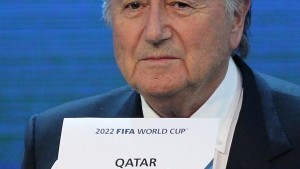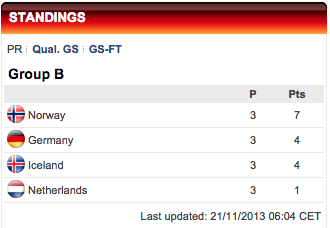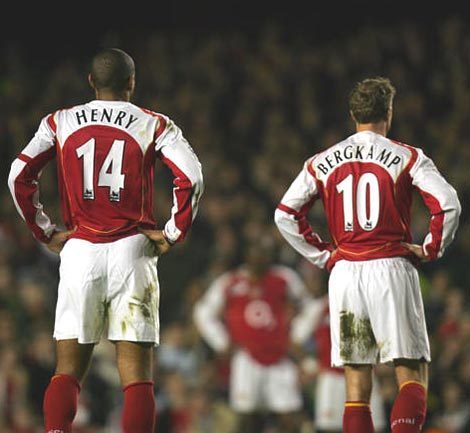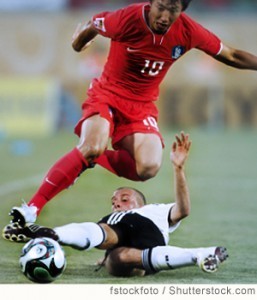Laurent Dubois's Blog, page 65
April 21, 2015
Bubble Soccer
Our course has focused on developments in international soccer, and to complement our analysis of soccer politics, I thought it would fun to share an update about a recreational spin-off of the sport: bubble soccer.

Retrieved from http://www.2mencave.com
Bubble soccer is more or less what it sounds like. Participants play soccer while strapped into inflatable, plastic bubbles. The players frequently rebound off each other during high-speed collisions and end up rolling on the ground.
Bubble soccer first started in Norway and spread throughout Europe. In the United States, the National Association of Bubble Soccer (NABS) has active leagues in 32 cities with thousands of registered players. Unsurprisingly, the rules of bubble soccer are different than traditional soccer. VICE Sports reports the games are played in six to seven minute quarters with five to eight players per team, depending on the field. There is considerably more physical contact in bubble soccer, although NABS has implemented rules similar to ones in the NFL that ban hits on defenseless players.

Retrieved from http://articles.chicagotribune.com/20...
Although official leagues exist, other companies also rent the equipment for birthday parties or other small events. I first encountered bubble soccer while I was walking through my neighborhood last summer. A group of elementary school students was running around a soccer field with bubbles strapped on their bodies. Most of them were so short that if their bubbles rolled upside down, they got stuck with their feet in the air and had to wait for the referee to tip them back over.

Retrieved from http://www.tennessean.com/story/news/...
Despite the fact that much of the integrity of soccer is lost, bubble soccer offers a way for people who are out of touch with the sport to become more involved. For example, several of my friends played bubble soccer last summer during a company-sponsored orientation event. Other than bubble soccer, these girls probably wouldn’t have touched a soccer ball since high school. Bubble soccer is also tremendously fun for spectators, and it’s almost impossible to watch video footage of a game without laughing.
A few years ago, an article on Bubble Football was published on our class blog in French. Read the article here!
April 20, 2015
Se muere Eduardo Galeano
El 13 de abril del 2015, falleció el autor uruguayo Eduardo Galeano. Galeano era reconocido mundialmente por sus opiniones políticas izquierdistas y por su periodismo. Escribió varios libros como Las venas abiertas de América Latina y Patas Arriba. Una de sus obras más famosas fue El futbol a sol y sombra que hablaba de la tradición futbolística en Sudamérica. Además de ser reconocido por su intelectualismo también era reconocido por su amor al futbol. A Galeano le encantaba el futbol porque le fascinaba la idea que el deporte podía sobrevivir la corrupción y desorganización. Otro aspecto del futbol que le gustaba mucho también era el elemento de sorpresa que tiene el deporte. Una frase muy conocida de Galeano era que “podías cambiar tu esposa pero no tú equipo favorito de futbol”. Durante toda su vida, Galeano escribió varios artículos relacionados al futbol y fue uno de los comentaristas más famosos. Era uno de los críticos más grandes de Joseph Blatter, el presidente de la FIFA, se refirió de Blatter como un “burócrata del fútbol que jamás ha pateado una pelota, pero anda en limusinas de ocho metros y con chofer negro”. Siempre fue un apoyador de los jugadores de ascendencia africana y siempre logró incorporar muchas de sus ideas socialistas en la manera que analizaba el deporte. Aunque el mundo literario siempre se burló de su pasión por el futbol, Galeano influenció a miles de comentaristas alrededor del planeta. A pesar de que Galeano ya no vive, el mundo siempre se va a acordar de su legado en el mundo futbolístico.

Foto de Eduardo Galeano
http://www.scholem.edu.ar/sites/defau...
April 19, 2015
The Tragedy of Javier Hernandez
Javier “Chicharito” Hernandez is a Mexican soccer player currently on loan from Manchester United to Real Madrid.

Chicharito at Real Madrid
Over the past few years Chicharito has struggled to gain the attention of managers of the clubs that he’s played on. During his tenure at Real Madrid he has only had the chance to play 848 minutes and was often overlooked in favor of Ronaldo, Benzema, and Bale and will not be signed permanently by Real Madrid at the end of his loan period. In retrospect, the loan did not make much sense for Real Madrid as they already have a plethora of players who can play at the top and do not need another. On Manchester United Hernandez showed excellent form his first season, scoring an incredible number of goals and proving himself to be a great buy. However after this season, Hernandez didn’t reproduce this performance and was quickly benched by Louis van Gaal, a situation that he never quite seemed to recover from.
With his loan to Madrid expiring at the end of the 2014/2015 season and his Manchester United contract ending in 2016, Chicharito has an opportunity to think about what his next move will be. It seems that the most obvious option would be to return to the premier league where he seems to be at his best. However Louis van Gaal does not seem keen on Hernandez, as he has been used as a super sub for the last several years, and if Hernandez were to go back to Manchester United he may have to contend with the fact that he would not, in what should be the prime of his career, be a starter. On that note, it has been rumored that Manchester United has been looking to sell the striker to Southampton in a deal involving Nathaniel Clyne who has been actively pursued by Manchester United. In my opinion this could be a great move for Chicharito who may be better appreciated by Southampton and could get the playing time that he has been looking for.
The tragedy in all of this is that Hernandez is a brilliant player whose career has been cut short by a lack of playing time. Perhaps the root of this problem is that the teams Hernandez has played for the last couple of years (Manchester United and Real Madrid) are teams with deep pockets and no worries when it comes to signing big name players. Consequently Hernandez has simply been overshadowed by his peers on these teams and has, as a result never been given the chance to show his true worth. Hernandez still has a chance to shine in European soccer, he simply needs to be given a chance at a club that will appreciate his talent.
April 18, 2015
¿FIFA cambiará la ubicación del Mundial 2022 desde Qatar?
¿FIFA cambiará la ubicación del Mundial 2022 desde Qatar?
por Andrew Bihl
Nota: Este ensayo fue escrito en 11/03/14. Debido a esto, cualquiera información más reciente no está incluido.
En 2010, FIFA eligió a Qatar para anfitrión de la Copa del Mundo de 2022. Chocó al mundo. Qatar, un país pequeño en el oeste de Asia, no tiene una cultura fuerte de fútbol, y su equipo nunca ha participado en la competencia. Además, el país tiene una clima muy caliente y se falta la infraestructura necesaria para ser el sede del Mundial. Finalmente, ha habido reportes y noticias describiendo violaciones de derechos humanos cometidos durante el proceso de construir la infraestructura para el Mundial. Parece que todo el mundo no está de acuerdo con la decisión.
A pesar de esto, han pasado cuatro años desde la decisión inicial y Sepp Blatter, el presidente de FIFA, todavía insiste en que Qatar será el anfitrión. Qatar ya ha empezado las preparaciones para realizar el Mundial, y crearía un gran conflicto con el país si FIFA cambia la ubicación del Mundial ahora. Además, FIFA quiere que se celebre el Mundial en Qatar porque extendería la popularidad de fútbol en el oeste de Asia, lo que extendería la influencia de FIFA.
Hay muchas razones para cambiar la ubicación del Mundial, pero la evidencia indica que FIFA no intenta de cambiarla. Los oficiales han fallado en abordar los problemas alrededor la Copa del Mundo 2022, y sus acciones indican que no importa si hay problemas existentes de Qatar 2022. Sin embargo, tomando todo esto en cuenta, es más probable que sí FIFA seleccionará otro país para ser la ubicación de la competencia, porque las cuestiones actuales simplemente son demasiadas serias.
El hecho que eligieron a Qatar es muy sorprendente cuando se considera que FIFA supo muchos de los problemas antes de decidir. Por ejemplo, cuando Qatar aplicó para ser anfitrión, no tenía la infraestructura necesaria para realizar la competencia. En cambio, las otras naciones que querían realizarla son países con una cultura establecida de fútbol como Australia, Holanda, Bélgica, Japón, Corea, España, Portugal, y los Estados Unidos. Tienen las ciudades con hoteles y otros alojamientos, tienen los modos de transportación, y tienen los estadios para llevar a cabo una competencia deportiva grande. Qatar, en cambio, tendría que gastar el dinero para construir nueve estadios desde cero y para remodelar tres (Arellano). Además, este costo solo representa 1.5 por ciento del total que Qatar estimó para el presupuesto. Necesitaría crear la infraestructura para sostener no sólo los juegos en los estadios sino también los turistas que vendrían al país. En total, se estimó un costo de 200 mil millones dólares. Este número parece absurdo cuando se compara con el costo del Mundial 2014 en Brasil, el que costó unos 11 mil millones y fue más que cualquier otro en la historia del Copa del Mundo(Arellano, n. pag). Estos hechos demuestran claramente que por lo menos Qatar no fue la opción fácil ni práctica.
Por añadidura, hay otro problema práctico: el calor de Qatar. Durante el verano, la temperatura en Qatar puede superar los 50 grados centígrados (Pérez Salazar, n. pag). Estas condiciones pueden ser muy peligrosas para los jugadores y los aficionados. Inicialmente Qatar dijo que podría construir sistemas de control de la temperatura en los estadios, pero hay duda que la tecnología pueda funcionar exitosamente. Desde entonces, FIFA ha considerado otra opción: jugar durante el invierno (Pérez Salazar, n. pag). Sin embargo, la competencia tradicionalmente sucede en el verano durante junio y julio, y crearía muchos problemas si se realizara durante el invierno. Por ejemplo, las ligas mayores futbolísticas del mundo juegan a lo largo del invierno. Además, el invierno de 2022 es la fecha de los juegos olímpicos del invierno 2022, y esa competencia no se podría mover a otro tiempo. En suma, cambiar el tiempo de la Copa chocaría con otras competencias deportivas, pero parece que no posiblemente podría llevarse a cabo durante el verano.
Con todos estos problemas, es sorprendente que Qatar fuera elegido. En un reporte analítica que hizo FIFA sobre los países que aplicaron, Qatar fue el único que se clasificó como “alto riesgo”. Pero en 2010, 14 de los 22 miembros de la junta electoral de FIFA que selecciona la ubicación del Mundial votaron que sea Qatar el anfitrión, a pesar de los varios problemas con Qatar (Arellano, n. pag). La explicación única es la corrupción. FIFA ha tenido problemas con corrupción por mucho tiempo, y el Mundial 2022 añade a ellos. Según unos reportes, un representante para el fútbol Qatarí pagó cinco millones dólares a varios miembros de FIFA durante el proceso de seleccionar la ubicación del Mundial (Bond, n. pag). Un correo desde el mismo hombre, Mohamed Bin Hammam, fue enviado a Blatter preguntando si él fuera un “amigo” que pudiera confiar. Finalmente, desde 2010, múltiples ejecutivos de FIFA han abdicado sus posiciones en medio de acusaciones de corrupción (Arellano, n. pag). Es claro que FIFA tiene problemas éticos adentro de la organización.
Ahora, FIFA enfrenta problemas éticos nuevos. Más allá de las cuestiones prácticas, hay muchas cuestiones serias alrededor del proceso de preparación para la competencia en Qatar. La nación ya ha empezado a construir la infraestructura, y hay muchas violaciones de los derechos de los trabajadores, quienes son esencialmente esclavos. Según un reporte del Human Rights Watch, los trabajadores son principalmente de otros países, y las compañías constructoras van a esos países como India y Tailandia para encontrar ellos. Les emplean y les traen a Qatar para trabajar, y entonces roban las visas a los trabajadores. En unos casos, los empleadores cargan a ellos para el proceso de emplear. Además, los leyes de Qatar imponen que un trabajador no puede salir de su posición sin el permiso de la compañía (Qatar: Migrant Workers Face Abuse). En suma, cuando alguien consigue empleo con estas compañías, no puede salir.

Los trabajadores en Qatar están esclavizados
Todo esto se hace más terrible porque las condiciones de trabajo son muy peligrosas. Un estudio por Confederación Internacional de Sindicatos estimó que hasta 4000 obreros podrían morir trabajando por la Copa en 2022 (4.000 trabajadores podrían morir en las obras Del Mundial De Qatar). Además, el grupo Human Rights Watch ha encontrado que Qatar no reporta los muertos fielmente (Qatar: Migrant Workers Face Abuse). Un grupo llamado la Confederación Sindical estimó que uno 1.200 trabajadores habían muerto en menos de dos años de trabajo(La masacre del mundial de Qatar). Sepp Blatter, el presidente de FIFA, simplemente dijo que algo necesita cambiar, pero dijo que FIFA no es responsable para los apuros de los obreros (“Blatter: FIFA no es responsable por obreros en Qatar).
Normalmente, una organización internacional no podría ser tan indiferente hacia problemas éticos obvios como estos. Sin embargo, FIFA actúa sin reglamentación ni control externo. Es un grupo independiente, y además es un grupo con el poder increíble. Un ejemplo que demuestra este poder sucedió en 2012. En preparación para el Mundial 2014, FIFA tuvo que abordar un conflicto de intereses. Generalmente, los fanáticos pueden comprar la cerveza durante los partidos, y un patrocinador importante de FIFA es Budweiser. Sin embargo, Brasil hizo una ley en 2003 que puso fin a la venta de cerveza a los partidos porque tuvo un problema con violencia entre los fanáticos. La ley tuvo la intención de proteger la gente. FIFA, sin embargo, decidió que eso no fue aceptable, y convenció al gobierno de Brasil para cambiar la ley de Brasil (Brazil Signs World Cup Beer Law).
Otro ejemplo aún peor es el caso de los tribunales del Mundial 2010 en Sudáfrica. FIFA, para combatir el crimen durante la competencia, estableció 56 tribunales en la nación para ocuparse de los crímenes asociadas con el Mundial. Los tribunales, que se establecieron con el permiso del gobierno de la nación, realmente tuvieron el poder de castigar a ellos quienes cometieron los crímenes. Además, la manera en que llevaron a cabo la justicia fue muy dudable. En un caso, dos hombres robaron a un periodista el miércoles, fueron al tribunal el jueves, y el viernes empezaron sentencias de 15 años en el cárcel (Hughes, n. pag). Tres días no basta para decidir el futuro de un individuo. Esto demuestra el poder de FIFA de operar sin considerar el bien y el mal. Parece que simplemente a FIFA no se importa la opinión pública.

La sala de conferencias de FIFA
En fin, ahora bien, FIFA sí tiene que considerar la opinión pública. El Mundial 2014 en Brasil trajo publicidad mala porque pareció que el gobierno estaba más enfocado en la Copa del Mundo que las necesidades de los ciudadanos, y perjudicó la imagen de FIFA y la de fútbol internacional (Benavides, n. pag). Ahora, con los ojos del mundo sobre ellos, los oficiales de FIFA deben tener cuidado. Sí la opinión pública se hace demasiado mala, podría costar a FIFA mucho. Por ejemplo, cuatro patrocinadores de FIFA, Sony, Adidas, Coca Cola, y Visa, recientemente hicieron declaraciones denunciando la reacción de FIFA a las acusaciones de corrupción. Adidas, un socio de FIFA desde 1970, resumió las preocupaciones: “El tenor negativo del debate público respecto a la FIFA en este momento no es bueno ni para el fútbol ni para la FIFA y sus socios” (Weir, n. pag). Para estas empresas, el propósito de ser patrocinadores es ganar dinero mejorando su imagen, y el éxito de eso depende en las acciones de FIFA.
FIFA, por consiguiente, podría perder dinero y influencia si ignoran los problemas de Qatar. Y, como sucedió en Brasil 2014, los problemas de Qatar 2014 tendrán la máxima publicidad cuando empiece el torneo. Además, el éxito de FIFA depende últimamente de los jugadores, las ligas, los gobiernos, y los consumidores. Si cualquier de esos grupos decidiera que no aceptaría las acciones de FIFA, el imperio internacional de fútbol cesaría de funcionar.
La pregunta, en fin, es esta: “¿Cuál decisión sería la mejor para los miembros en FIFA y el éxito de la organización?” Parece, para concluir, que se tendría que mover el Mundial a otro país. Cuando se considera las repercusiones del Mundial en Qatar, se deduce que no es una buena idea. Todas los asuntos de los derechos humanos, los conflictos de horario, y la corrupción atraerían mucha atención. Podría causar una reacción violenta del público. Ahora, aunque los delitos mismos existen, el público no le importan porque no están en los periódicos. FIFA tiene la oportunidad de evitar la publicidad por elegir una ubicación nueva antes de 2022. Un país como los Estados Unidos o un país Europea tiene la infraestructura y el gobierno para ser anfitrión sin polémica, y esto estaría a favor de FIFA. Por eso, FIFA probablemente cambiará el anfitrión del Mundial 2022.
Works Cited
“4.000 trabajadores podrían morir en las obras del Mundial de Qatar.” ABC.es. Diario ABC, 26 Sept. 2013. Web. 03 Nov. 2014. .
Arellano, Alberto. “Qatar 2022: La corrupción que corroe a La FIFA.” Ciperchile.cl. CIPER, 17 June 2014. Web. 02 Nov. 2014. .
Benavides, Sofía. “La otra cara de la Copa del Mundo: 250.000 Desalojos En Todo Brasil | Mundial Brasil 2014, Brasil.” Infobae América. Infobae, 19 Jan. 2014. Web. 10 Nov. 2014.
“Blatter Defends Qatar Decision.” The World Game. SBS, 9 Nov. 2012. Web. 03 Nov. 2014. .
“Blatter: FIFA no es responsable por obreros en Qatar.” El Nacional Deportes. El Nacional, 2 Dec. 2014. Web. 03 Dec. 2014. .
Bond, David. “Qatar World Cup: £3m Corruption Claim.” BBC Sport. BBC, 31 May 2014. Web. 03 Dec. 2014. .
“Brazil Signs World Cup Beer Law.” BBC News. BBC, 06 June 2012. Web. 03 Dec. 2014. .
Hughes, Rob. “Swift and Severe Justice at World Cup Courts.” The New York Times. The New York Times, 20 June 2010. Web. 03 Dec. 2014. .
“La FIFA nunca publicará el informe definitivo sobre Qatar 2022.” El Correo Del Golfo. El Correo Del Golfo, 22 Sept. 2014. Web. 03 Nov. 2014. .
“La masacre del Mundial de Qatar: Más De 1200 Muertos En La Construcción De Los Estadios.” Mundo D. La Voz Del Interior, 19 Mar. 2014. Web. 11 Nov. 2014.
Pérez Salazar, Víctor. “El rompecabezas de jugar en invierno El Mundial De Qatar 2022.” ABC.es. Diario ABC, 23 Sept. 2013. Web. 02 Nov. 2014. .
“Qatar: Migrant Construction Workers Face Abuse | Human Rights Watch.” Qatar: Migrant Construction Workers Face Abuse | Human Rights Watch. Human Rights Watch, 12 June 2013. Web. 02 Nov. 2014. .
“Rival de Blatter quiere Mundial 2022 en Estados Unidos.” Univision.com. Univision, 25 Oct. 2014. Web. 02 Nov. 2014. .
“Sepp Blatter ‘did Not Question Qatar’ as World Cup Host, Says FIFA.” CNN. Cable News Network, 16 May 2014. Web. 02 Nov. 2014. .
Tuttle, Robert. “Money Can’t Buy Qatar Love: $200 Billion in World Cup Spending Jeopardized Over Alleged Corruption.” Bloomberg.com. Bloomberg, 5 June 2014. Web. 02 Nov. 2014. .
Weir, Keith, and Ossian, Shine. “Patrocinadores aumentan presión sobre la FIFA por acusaciones sobre Qatar.” Reuters América Latina. Reuters, 09 June 2014. Web. 10 Nov. 2014.
April 17, 2015
Soccer and Snapchat
This is a pretty cool article about Snapchat at the US vs. Mexico friendly this past weekend. I personally forgot the friendly was even taking place—until I checked my Snapchat in the middle of the afternoon and found a “Live Story” of the game. The Live Story allowed people attending the game to submit a Snapchat (a 10-second-or-less video or picture) to potentially be a part of an approximately 300-second-long video/photo stream of the event, able to be viewed around the world. In the past, there have also been Live Stories of the NCAA Final Four, the Daytona 500, and the Superbowl.
The reason soccer made it to the forefront of one of the most widely-used social media platforms? Jill Hazelberger, Snapchat’s VP of Communications, said it was because of “increased interest in the sport over the past decade” in the United States. She also mentioned partnering with Univision to launch the Live Story because “no one can match Univision’s reach into Spanish-speaking America,” and that the friendly’s coverage was Snapchat’s first clear attempt to do so.
Whatever Hazelberger and Snapchat’s aims, for me, it was a pleasure to witness the game through the eyes (or smartphones) of those in attendance. I often take a look at the Live Stories just for fun or when I’m bored, whether they display a sporting event or a peek into a big city (Dubai was a cool one this past week)—but, as Hazelburger suggested, and as we’ve been learning all semester, the appeal of soccer is “increasing” and even more so widespread around the world than mostly any other event a Snapchat Live Story could cover. From the tailgates, to the U.S.’s two goals, to the cheering and jabs between the U.S. and Mexico fans in the crowds, the Live Story was an amazing sight to see, and made me feel as though I was right there in the action. If Hazelburger’s implication proves to be correct, this won’t be the last Live Story surrounding a soccer event (actually, when I was in Madrid, there was a Live Story for Real Madrid-Barcelona!). It’ll also provide a chance for soccer, on such a popular and widely used platform, to not only reach Spanish-speaking America, but to also reach many other Americans who are just looking at their phones in the middle of the day.
April 14, 2015
Germany
Winners of the 2003 and 2007 FIFA women’s world cup, the Germany women’s national team is seeking to win its third trophy at the 2015 FIFA women’s world cup. Germany will be entering the 2015 world cup ranked as the number 1 team in the world and have never ranked lower than 3 in the national FIFA women’s rankings. Along with being the number 1 ranked team entering the tournament, Germany’s player to watch is captain Nadine Angerer
 Germany Women’s team ranking from FIFA
Germany Women’s team ranking from FIFA
Performance at the 2011 FIFA Women’s World Cup
In the last edition of the FIFA Women’s World Cup, the Germany Women’s side failed to come out as champions on home soil after falling to eventual winners Japan in the quarterfinals. Having won the 2007 women’s world cup and being ranked second in the world, the German squad was a favorite to win the tournament. Needless to say, it came up as quite a shock when the Germans fell out early in the quarterfinals to Japan.
While Germany were reigning world champions and playing on home soil, their world cup campaign had a bit of a rough start. Being put in a group that featured two other teams that were ranked in the top 10 globally, Canada (6) and France (7), along with African powerhouse Nigeria (27), who were the reigning African Women’s Champions at the time, the group stage was by no means going to be a walk in the park for the Germans. The Germany women’s national team opened up their tournament campaign with a hard-fought 2-1 victory against Canada’s women national team with goals from Kerstin Garefrekes and Celia Okoyino Da Mbabi. The German national side then just managed to hold off Nigeria to earn a 1-0 victory, being unable to capitalize despite having 6 shots on goal to Nigeria’s 1. It was in their final group game against France where the Germany women started to show their dominance, earning a 4-2 victory over their opponents to top their group.
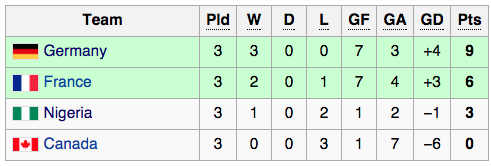 2011 FIFA women’s world cup standings for group A from Wikipedia.
2011 FIFA women’s world cup standings for group A from Wikipedia.
Topping their group, the Germany women were set to face the runner’s up of group B, Japan, to commence the knockout stage. Following an intense and physical 90 minutes of regular time, both Germany and Japan had been unable to find the back of the net and had gone into extra time. Defeat came just 3 minutes into the start of the second half of extra time as Japan’s Karina Marayuma managed to slip one past Nadine Angerer and with that crush Germany’s hope of repeating as women’s world champions.
Germany vs Japan 2011 courtesy of FIFATv
Post 2011 Women’s World Cup
2013 UEFA Women’s European Championship
Having failed to qualify for the 2012 summer Olympic games, the Germany National team qualified for the 2013 European Women’s Championship and looked to repeat as European champions. Just like the 2011 FIFA Women’s World Cup, the Germany women’s national team entered the tournament ranked 2 globally. Germany opened up group play with a scoreless draw against the Netherlands. Following the opening draw, Germany managed to win their second group stage match 3-0 against Iceland in a very convincing manner. In their last group stage match, the Germans fell to Norway 1-0 and came in as runners up for their group.
Group B Standings from UEFA
The knockout stages of the European champions were tough for the reigning champions. In their quarterfinal matchup Germany were set to face Italy, who had also come in as runners up of their group, where Germany would win after Simone Laudehr scored the only goal of the game. In their semifinal matchup, Germany faced hosts Sweden and won thanks to a goal from Dzsenifer Marozsán. In the finals, Germany played Norway for the European championship and won the rematch after Anja Mittag struck the back of the net just three minutes after being subbed in.
2015 FIFA Women’s World Cup
For the 2015 edition of the Women’s World Cup, the Germans have been given 4/1 odds of winning by Westgate. They will be entering the tournament ranked as the number 1 team globally.
Player to watch: Nadine Angerer

Image of Nadine Angerer from http://upload.wikimedia.org/wikipedia...
Nadine Angerer made her international debut in 1996, but did not become the starting goalkeeper for the national team until the 2007 FIFA women’s world cup, where she played a huge role in her teams success in winning the tournament. Since establishing herself as the first-choice keeper for the national team, Angerer has proven to be a consistent and important player for the Germany women’s national team. Angerer has led Germany to 2 European championships and 1 World Cup. She has worn the captain’s band for the Germans since 2011 and led them to a European championship while being named player of the tournament in the 2013 European Championship and being named the 2013 women’s world player of the year. Having started her career playing for FC Nürnberg in Germany, Angerer now plays for the Portland Thorns of the United States. Having won so many accolades, Angerer now looks to captain her country to her third world cup title.
Nadine Angerer Recieves 2013 Fifa World Player of the year award.
Works Cited:
1. “2011 FIFA Women’s World Cup Group A.” Wiki. Wikimedia Foundation, n.d. Web. 11Apr. 2015. http://en.wikipedia.org/wiki/2011_FIFA_Women%27s_World_Cup_Group_A
2. Press, The Associated. “Japan Stuns Germany at Women’s World Cup – CBC Sports – Soccer.” CBCnews. CBC/Radio Canada, 09 July 2011. Web. 11 Apr. 2015. <http://www.cbc.ca/sports/soccer/japan-stuns-germany-at-women-s-world-cup-1.1019356>.
3.”Germany – Japan, 2011 Women’s World Cup.” YouTube. YouTube, n.d. Web. 11 Apr. 2015. https://www.youtube.com/watch?v=7ePK6l664UM
4. “Nadine Angerer: – CNN.com.” CNN. Cable News Network, n.d. Web. 11 Apr. 2015.http://edition.cnn.com/2015/01/14/football/football-nadine-angerer-goalkeeper/
5. “2015 FIFA Women’s World Cup Odds – USA Opens as Favorite.” Linemakers. N.p., n.d. Web. 11 Apr. 2015. http://linemakers.sportingnews.com/article/4635523-womens-world-cup-odds-2015-betting-lines-las-vegas-usa-germany-brazil-japan
6. “The FIFA/Coca-Cola World Ranking – Associations – Germany – Women’s – FIFA.com.” FIFA.com. N.p., n.d. Web. 11 Apr. 2015. http://www.fifa.com/fifa-world-ranking/associations/association=ger/women/index.html
7. “UEFA Women’s EURO 2013 – History – Germany-Norway – UEFA.com.”Uefa.com. N.p., 28 July 2013. Web. 11 Apr. 2015. http://www.uefa.com/womenseuro/season=2013/matches/round=2000178/match=2011602/postmatch/report/index.html
8. “Nadine Angerer: Women’s World Player 2013 Award Reaction.” YouTube. YouTube, n.d. Web. 12 Apr. 2015. https://www.youtube.com/watch?v=UaNo4Bs6mFk
9. http://en.wikipedia.org/wiki/Nadine_Angerer#/media/File:2011-08_Nadine_Angerer.JPG
10. “FIFA Women’s World Cup Germany 2011.” FIFA.com. N.p., n.d. Web. 12 Apr. 2015.
April 13, 2015
Why Thierry Henry should not succeed Arsene Wenger
Following a post on this forum on ‘Who should replace arsene wenger‘ in which the author suggests Theirry Henry is the best candidate, I felt the urge to respond with reasons why I believe Thierry Henry, my all time favorite player is not the right man to take over from Arsene Wenger.
Just to set the record straight, I believe for the eight years he was at arsenal, Henry is the greatest of all time Arsenal player. He is Arsenal’s leading goal scorer having netted 228 times way ahead of the second placed Ian Wright who scored 185 goals for Arsenal.I even grew up idolizing Thierry Henry. His times at Arsenal were memorable ones, we dare not forget those times. That legendary goal against tottenham hotspurs. . . . .
Those were indeed great times at Highbury. . .
Henry was great, and he scored great goals and ‘we’ won trophies. In his greatness, however, I believe he lacked the most important quality Arsenal needs at the moment, Loyalty !!!. Loyalty to the club and coach who took him from Ajax at 21 years of age and converted him from a little known winger to arguably world’s most lethal central striker at the time. We seem to forget that Henry left Arsenal at the prime of his career to go play for Barcelona because he believed it was the better team to win trophies with. Had players like Bergkamp bolted at the prime of their careers for the better clubs so as to win trophies then Arsenal would never have won any trophies of its own. Henry is partly to blame for the long trophy drought that Arsenal has experienced. Had he stuck around when things were not good he would have allowed the club to build a team around him and win more trophies.
I believe Henry is the genesis of what has become Arsenal’s biggest problem today, the club where young players leave immediately they feel that they are knocking on the door of stardom. The likes of Van Persie, Fabregas, Clinchy, Song, Flamin, Hleb, Sagna and others left immediately they felt they were world-class claiming they wanted to win trophies just like Henry had done. Before Henry left Arsenal such stories were unheard of at Arsenal. He started the culture of leaving to win trophies somewhere else and Arsenal players believing they cannot win at their club. It is a bad culture, the main reason many Arsenal fans cant even tell how it feels to win the premier league or champions league. And now you believe he is the man to lead Arsenal ? What happens when he starts winning big as a coach and Barcelona or Madrid comes knocking with big money and better talent ?. I was a big fan and am still one but I dont think Thierry Henry is the man, loyalty is important and for Arsenal no man represents that better than Bergkamp, that’s my guy to lead the gunners across the river to the promised land.
April 11, 2015
A Case Study of Soccer Ethics
There are the published rules of the game, like the offsides rule, no hands, and so on. And then there are the actual rules of the games- the ones that aren’t necessarily published but guide the way we act and interact with the published set of rules. These unspoken rules, or norms, are what form soccer ethics.
The ethics of soccer is a complicated topic to approach. First of all, soccer is a global sport, so its ethical lines transcend the boundaries of nations. Yet, regional differences clearly play a role in what is considered ‘right’ and ‘wrong’ action in sports as well as in daily life.
However, there are definite cases of ethical lines and boundaries. I am going to look at two separate instances- one where a rule was broken and there were no ramifications, and one where a rule was broken and punishment was swiftly and strictly administered.
CASE ONE: A broken rule with mixed reactions
On the 22nd of June, 1986, Argentina defeated England in a World Cup quarterfinal, partly in thanks to a controversial goal scored by Diego Maradona. The goal, referred to as the ‘Hand of God,’ was clearly in violation of the rules, as video shows. Neither referee were sure at the time whether or not it had been a violation, but videos show Maradona’s use of his hand. The goal illicited intense reactions from soccer fans- some celebrated the goal, others decried it- but no further action was taken[1]. So, while the act wasn’t necessarily a ‘good’ one, it wasn’t deemed ethically wrong enough for outside entities to step in.
So what we’re left with is an example of when breaking the rules is morally acceptable. Maradona used his hand, in clear violation of basic football rules, but he wasn’t punished for it. His goal counted, the win stood, and there were no other ramifications. While some people were upset, it isn’t all that clear whether it was English fans that were more upset over losing because of the illegal goal or if they actually rejected Maradona’s rule-breaking goal on principle. Rather, his goal is more often met with general amusement, sly smiles, and blame on the refs for not calling it- not on the player for trying it [2].
This stands in stark contrast with Case Two.
CASE TWO: A broken rule resulting in punishment
In a match against Italy during the 2014 World Cup, Uruguayan player Luis Suarez appeared to have bitten Italian defender Giorgio Chiellini. This type of violent action against an opposing player is clearly against the rules- it’s prohibited, just as the use of a hand is also prohibited. Yet, this act caused a stronger reaction in response. The act is condemned and abhorred, and Suarez was, after the game was over and the incident reviewed, suspended from “all football-related activity” for four months, as well as having to pay a fine for the incident [3]. This action was strictly met with punishment- not amusement.
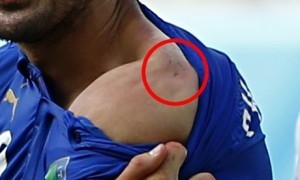
Italy’s Giorgio Chiellini after he was bitten by Luis Suarez.
Suarez’s action crossed some unspoken ethical line. But that ethical line doesn’t seem so clear.
Perhaps the line is injury- that doing something that would likely injure an opponent is considered unethical. This seems like a compelling option. After all, we like to think that this is true, and we even act like it is at times. For instance, players ‘flop’ or fake extreme pain to increase the likelihood that the other player will be reprimanded and have a foul called on them.
But is it really as simple as that? If we really, truly believe that intentionally causing injury is wrong, then why do we allow and encourage certain types of behavior that almost always result in injury? For example, slide tackles are painful, and I would argue that, to some extent, a player that slide tackles another intends to cause some slight form of injury. That could be a scraped knee, a jolt from hitting the ground hard, pressure on the ankles, and so on. And some people even encourage particularly painful-yet still legal- slide tackles for the very reason that they will hinder the activity of that player in some way if they are executed correctly.
So maybe ‘causing injury’ was too simplistic of an ethical line to draw. Perhaps it’s a little deeper, or a more theoretical idea of ‘wrong.’ Perhaps people rejected Suarez’s act as opposed to Maradona’s because the biting was inhumane or animalistic. Yet, again, I can think of a million examples where the same people that condemn Suarez also fight each other like vicious animals in the stands, hurtle horrific insults at the athletes, and plenty of other inhumane activities like that. So perhaps that’s not it either.
In sum, there are a couple of things that we take away from this discussion. While it is unclear what ethical line Suarez crossed to elicit such a harsh response, it is clear that the rules of the game aren’t inherently ‘right’ or ‘moral.’ There are instances where breaking the rules doesn’t really matter, because people don’t tie any deeper ethical significance to the rule in the first place. Thus, soccer ethics is separate from the rules of the game.
Furthermore, it’s very difficult to quantify or explain the ethical norms and ideas surrounding the game of football. Football is a global sport influenced by a global span of ideas of what is ‘right’ and ‘wrong.’ There are regional differences, ethnic differences, personal differences, and so on that add to the difficulty of pinpointing an objective ethical line. But while it’s hard to clearly explain or see what our ethical ideas are, the paradox of it all is that ethics dictate our actions (related to soccer and beyond) more than the rule of law could ever do.
References:
[1] http://www.we-heart.com/2014/06/10/ma...
[2] http://www.express.co.uk/news/uk/4843...
[3] http://www.bbc.com/sport/0/football/2...
What is going on in the soccer world right now…?
In the past three days, the soccer world has been flooded with terrifying stories of soccer-related bombings, Nazi chants, and even an attempted choking on an airplane. Although I haven’t been following the sport of soccer for very long, this burst of soccer-related violence and hate is both unexpected and depressing. But if anything, these recent events of violence again prove that the world of soccer and the world of politics are, and will always be, completely intertwined. Here’s a brief look at the recent events.
In Cyprus, there have been six recent car bombings – targeting referees, a referee’s wife, and even a referee’s mother. One group has claimed responsibility for some of the bombings, releasing a statement expressing their goal to fight corruption in the sport. Specifically, match-fixing is rumored to be pervasive throughout the sport in Cyprus, from the player level to league executives and referees. Marios Panayi (a former referee from Cyprus) recently spoke of the corruption, stating that he believed only 10 percent of current referees were clean. Panayi also believed that one senior official in the Cyprus Football Association was fixing matches to remain in power and make money off of television deals. Like many other Eastern European soccer leagues, money is largely blamed as the reason for corruption in the Cypriot soccer league.

What remained after a bomb targeted a referee’s car outside of his home. Source: New York Times
In other news, a Dutch soccer game in Utrecht between FC Utrecht and Ajax Amsterdam was filled with Nazi chants and other feelings of anti-Semitism. Home fans chanted, “Hamas, Hamas, Jews to the gas / My father was in the commandos, my mother was in the SS / Together they burned Jews, because Jews burn the best.” As evidenced by another incident in February when Chelsea fans prevented a black man from boarding the Paris Metro, unfortunately discrimination and racism are issues that have long been an issue within the sport of soccer. There have been 59 reported instances of anti-Semitism in the past first-half of the season, a dramatic increase from the previous season. Human rights officials like Shimon Samuels attribute this burst in anti-Semitism to a combination of neo-Nazis and jihadists, and also the difficulty that leagues and teams have in controlling fans (which they still need to support the team and buy tickets). Some have offered the idea of protesting games where chants like these occur (where players would walk off the field and halt play), but unfortunately these ideas have yet to be executed. Samuels believes that fans must detach football from politics for the greater good of the sport, but is this really a feasible aspiration to turn towards?
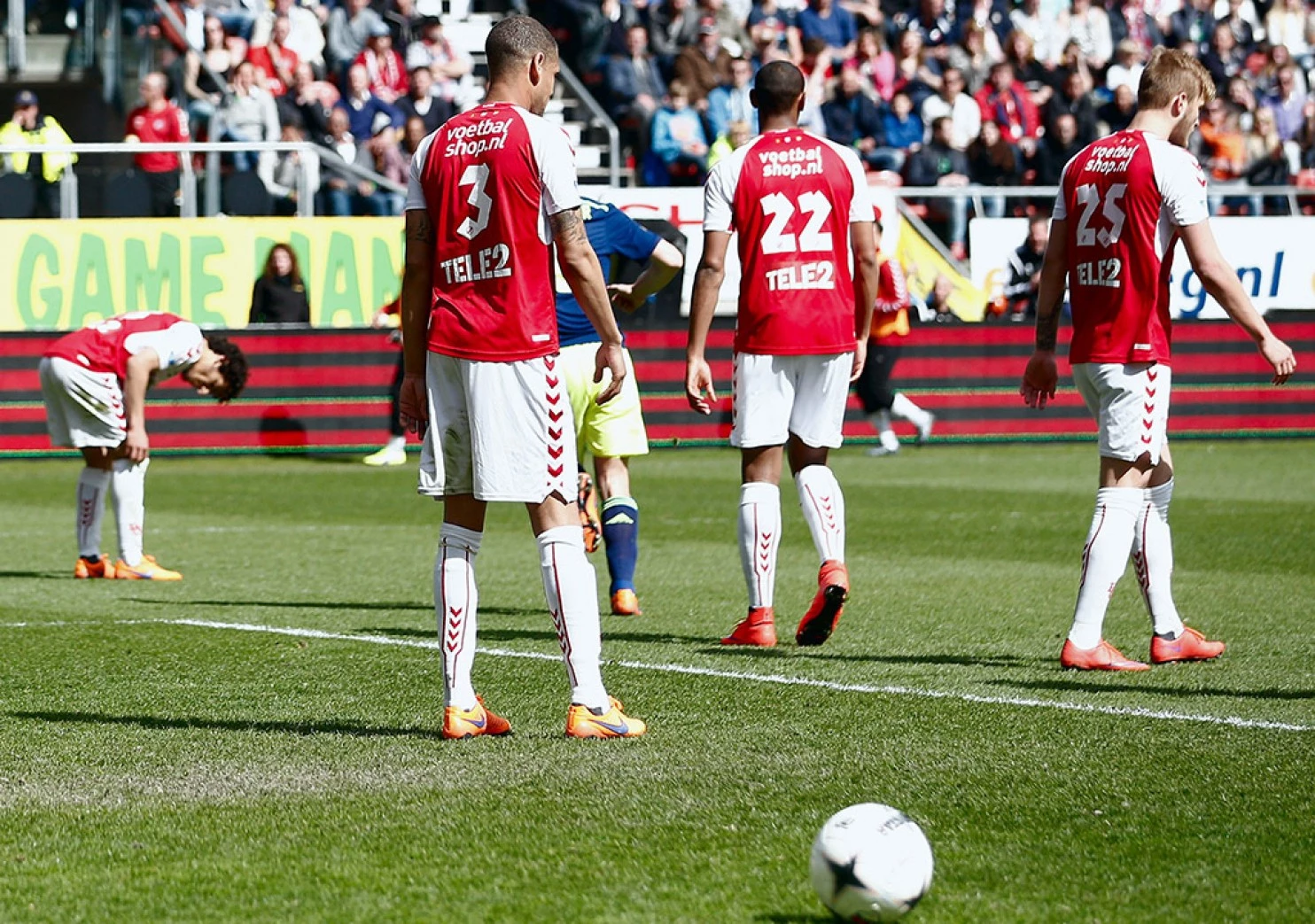
A soccer game between FC Utrecht and Ajax Amsterdam, in which chants of anti-Semitism were heard. Source: Washington Post
And finally, on a flight from Toronto to Atlanta, a male individual sitting behind Brazilian soccer player Oliver Minatel attempted to choke the player with the cord from his headphones. According to a witness on the plane, the individual believed that “this soccer team (Ottawa Fury FC) was trying to kill him,” and thus officials subjected the individual to a mental health evaluation upon landing in Atlanta. Minatel suffered no injuries, and there isn’t much other information on the individual’s reasons for choking Minatel. Although it’s unclear whether the perpetrator of the attack was mentally stable and had a real reason for attacking the soccer player, this incident shows that soccer is able to ignite a violent response from an individual.
These recent events in the soccer media are both troubling and saddening. There are many issues within the sport that transcend the simple idea of just playing the game. And no matter how much people want to disconnect the sport from politics, they will always be closely intertwined.
Jean Williams at the Soccer Symposium
Yesterday morning, I had the opportunity to attend the first portion of “The Future of Women’s Soccer” Symposium, hosted by Jean Williams. In her session, Women and Soccer: Research Agendas and Policy Debates, Williams provided a chronological narrative of women’s football, outlining both the triumphs and obstacles that define it. As we all may have realized after reading A Beautiful Game, Williams represents one of the premier intellectuals regarding women’s football and its surrounding history. Her discussion provided great a great factual background on the history of women’s football and elicited key underlying issues that have unfortunately remained persistent throughout the same course of time.
Similar to A Beautiful Game, much of Williams’ narrative revolved around England’s Dick, Kerr’s Ladies F.C, one of the earliest known women’s football teams. In its 828 game history (spanning from 1917 to 1965), Dick, Kerr’s Ladies won 758 games, drew 46, and lost only 24. Led by prolific goal-scorer Lily Parr, Dick’s Kerr Ladies enjoyed an unfathomable amount of success throughout its history. In the roughly 3,000 goals that Dick, Kerr’s Ladies scored throughout its history, it is believed that Parr was on the end of nearly 1,000 of them. Despite drawing typical crowds of 5,000 paying individuals (many of whom were working-class men), the FA placed a ban on women’s football in 1921, halting the ever-growing popularity and success that women’s football had began to garner.
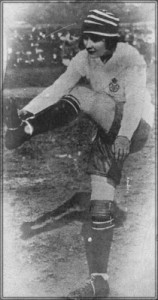
DIck, Kerr’s Ladies star, Lily Parr (courtesy of wikipedia.org)
Williams’ research indicates that there has undoubtedly been an unprecedented level of connectivity amongst women active in the football industry since the 1950s. Although the battle has been largely uphill, women footballers have maintained solidarity, and have overcome the constant adversity thrown their way. Whether it be the lack of a singular collection of women football memorabilia –there exists no women’s exhibit in the National Football Museum in Manchester, England– to the binary that separates Men’s and Women’s football, women’s football cannot be defined without paying tribute to the adversities that it had to overcome to get where it is today.
As we can see from this upcoming 2015 World Cup, women can now finally earn full time professions as players. However, just as recently as 1969, there existed an FA ban on women’s football. Although João Havelange pushed for the implementation of a Women’s FIFA World Cup in the late 1980s, Williams postulates that he did so simply as a way to trademark a competition in order to garner a revenue stream.
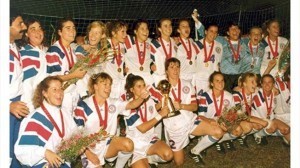
The U.S Women’s National Team after winning the inaugural FIFA Women’s World Cup in 1991 (courtesy of FIFA.com)
Although Williams is very confident that the women’s game will continue to grow in popularity and presence, she finds that the binary logic between men’s and women’s football mars some of the progress that has occurred throughout the years. Though there have certainly been enormous expansions for women’s football –such as the new women’s football headquarters facility in Switzerland- Williams hopes that the game we all love will one day only be referred to as “football” rather than “men’s and women’s football.” Williams did not end her discussion by offering answers as to how this might be achieved, but rather, offered issues that we as a society need to discuss before we can find any viable solution. Who benefits from these binaries? Who does not benefit? How might ancillary roles (refs, asst. coaches, administrative positions) become unbiased as well? What can we do to further cement women’s football as a legitimate industry in the sporting world? Although there is no easy answer to any of these questions, I am confident that active discourse will ultimately yield answers, hopefully resulting in a more unbiased football landscape.
(To learn more about the history of women’s football, I suggest that you visit Patrick Brennan’s website: http://www.donmouth.co.uk/womens_football/womens_football.html)
Laurent Dubois's Blog
- Laurent Dubois's profile
- 44 followers


